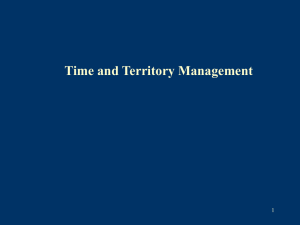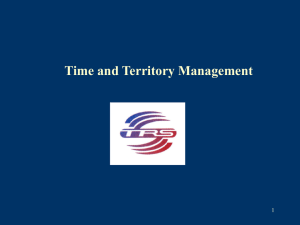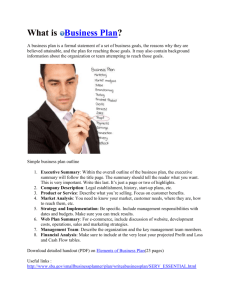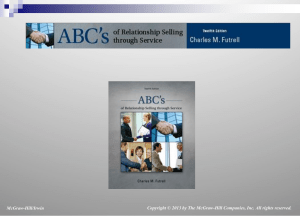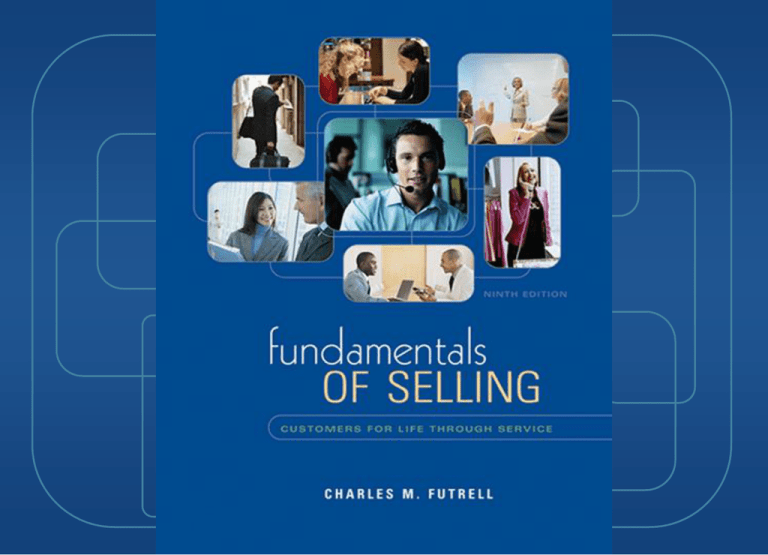
15-1
Time, Territory, and SelfManagement: Keys to Success
McGraw-Hill/Irwin
Chapter
15
Copyright © 2006 by The McGraw-Hill Companies, Inc. All rights reserved.
Chapter
15
15-3
Main Topics
The Tree of Business Life: Time
Customers Form Sales Territories
Elements of Time and Territory Management
Chapter
15
15-4
The Tree of Business Life: Time
T
T T
T T TT
T T T T
Builds
Guided by The Golden
Rule:
View your territory as a business
Treat customers differently
Relationships
15-5
depending on their needs
Value the customer’s time
Realize that how you spend your
time determines your life
Use your life to serve others and
enjoy a wonderful, fulfilling life
Seek, knock, ask, serve, and see
that ethical service build true
relationships
Customers Form Sales Territories
A sales territory comprises a group of
customers or a geographical area assigned to a
salesperson
15-6
IL is split between
WA
MT
OR
ID
ME
ND
MN
WI
SD
WY
MI
IA
NE
NV
UT
CA
AZ
CO
VT
NH
MA
NY CT
PA
NJ
IL IN OH
KS
NM
OK
WV
MO
KY
TN
VA
NC
SC
AR
MS AL
DE
MD
DC
GA
TX
LA
FL
WEST COAST
SOUTHEAST
MID-ATLANTIC
MIDWEST
NATIONWIDE
(IL Accts A-L)
(IL Accts M-Z)
Vertical Market Managers (Pharma, Incentive
& SMERF)
NORTHEAST
15-7
Updated 1-10-06
Exhibit 15-1: Reasons Companies Develop
and Use Sales Territories
15-8
Why Sales Territories May Not Be
Developed
Salespeople may be more motivated if not
restricted by a particular territory
The company may be too small to be
concerned with segmenting the market into
sales areas
15-9
Exhibit 15-2: Elements of Time and
Territory Management for the Salesperson
Salesperson’s territory’s
sales quota
15-10
Elements of Time and Territory
Management
Salesperson’s sales quota (goals) may
involve:
Sales volume quotas
Profit quotas
Expense quotas
Activity quotas
Customer satisfaction scores
15-11
Exhibit 15-2: Elements of Time and Territory
Management for the Salesperson, cont…
Salesperson’s territory’s
sales quota
Account analysis
15-12
Elements of Time and Territory
Management, cont…
Account analysis:
The undifferentiated selling approach (Exhibit 15-3)
Using the same selling approach because all targeted accounts are exactly
he same
The account segmentation approach (Exhibit 15-6)
Used because accounts needs & characteristics are different and require
different selling strategies. Ex) Key accounts, Unprofitable & regular
accounts.
ELMS system
80/20 principle
20% of accounts produce 80% of revenue
Multiple selling strategies
Ex) sales force structure may be designed to meet the companies key
accounts (largest producers).
Multivariable account segmentation (Exhibit 15-7)
Using more than one criterion to characterize the organization’s accounts.
15-13
Exhibit 15-3: Undifferentiated Selling
Approach
Slide 15-11
15-14
Exhibit 15-4: Account Segmentation Based
on Yearly Sales
15-15
Exhibit 15-5: Basic Segmentation of
Accounts
15-16
Exhibit 15-6: Account Segmentation
Approach
Slide 15-11
15-17
Exhibit 15-7: Multivariable Account
Segmentation
Slide 15-11
15-18
Exhibit 15-2: Elements of Time and Territory
Management for the Salesperson, cont…
Salesperson’s territory’s
sales quota
Account analysis
15-19
Set account objectives
and sales quotas
Elements of Time and Territory
Management, cont…
Set account objectives and sales quotas
which may involve:
Sales volume quotas
Profit quotas
Expense quotas
Activity quotas
Customer satisfaction scores
15-20
Exhibit 15-2: Elements of Time and Territory
Management for the Salesperson, cont…
Salesperson’s territory’s
sales quota
Account analysis
Set account objectives
and sales quotas
Territory-time allocation
15-21
Elements of Time and Territory
Management, cont...
Territory-time allocation
How does the salesperson allot their limited time within their
respective territories?
Basic factors to consider
Number of accounts in the territory
Ex – GSO vs Local sales person
Number of sales calls made on customers
Time required for each sales call
Frequency of customer sales calls
Travel time around the territory
Nonselling time
Return on time invested
Sale response function (See up coming slide)
15-22
Exhibit 15-8: Account Time Allocation by
Salesperson
* every 3 months
15-23
Elements of……………….
Territory-time allocation
Basic factors to consider
Sales response function
The salesperson invests sales time in direct proportion
to the actual or potential sales that the account
represents
The most productive number of calls is reached at the
point at which additional calls do not increase sales
The relationship of sales volume to sales calls is the
sales response function of the customer to the
salesperson’s calls
15-24
Return on Time Invested
Time is a scarce resource
Must use time wisely in order to improve and maximize
territory productivity
Break-even analysis
The quantitative technique for determining the level of
sales at which total revenues equal total costs
The management of time
Plan by the day, week, and month
Qualify the prospect
Use waiting time
Have a productive lunchtime
Records and reports
15-25
Exhibit 15-10: Daily Customer Plan
15-26
Exhibit 15-2: Elements of Time and Territory
Management for the Salesperson, cont…
Salesperson’s territory’s
sales quota
Account analysis
Set account objectives
and sales quotas
Territory-time allocation
Customer sales planning
15-27
What is Involved in Customer Sales
Planning?
You do the following for each sales call:
Develop sales call objectives
Review/create customer profile
Create customer benefit plan
Select FABs
Develop marketing plan
Develop business proposition
Develop suggested order
Develop your sales presentation
15-28
Exhibit 15-2: Elements of Time and Territory
Management for the Salesperson, cont…
Salesperson’s territory’s
sales quota
Account analysis
Set account objectives
and sales quotas
Territory-time allocation
Scheduling and routing
15-29
Customer sales planning
Scheduling and Routing
Strict formal route designs enable the
company to:
Improve territory coverage
Minimize wasted time
Establish communication between management
and the sales force in terms of location and
activities of individual salespeople
Carefully plan your route
15-30
Exhibit 15-11: Location of Accounts and
Sequence of Calls
15-31
Exhibit 15-12: A Weekly Route Report
15-32
Exhibit 15-13: Three Basic Routing Patterns
15-33
Exhibit 15-2: Elements of Time and Territory
Management for the Salesperson, cont…
Salesperson’s territory’s
sales quota
Account analysis
Set account objectives
and sales quotas
Territory-time allocation
Territory and customer
evaluation
Scheduling and routing
15-34
Customer sales planning
Using the Telephone for Territorial
Coverage
Satisfy part of the service needs of accounts
by telephone
Assign smaller accounts that contribute less
than 5 percent of business to mostly
telephone selling
Do prospecting, marketing data gathering,
and call scheduling by telephone
Carefully schedule personal calls to distant
accounts
15-35
Exhibit 15-15: Net Sales by Customer and
Call Frequency: May 1, 2005
15-36
Territory and Customer Evaluation
Did the salesperson meet sales quota(s)?
Sales volume quotas
Profit quotas
Expense quotas
Activity quotas
Customer satisfaction scores
15-37
Exhibit 15-2: Elements of Time and Territory
Management for the Salesperson, cont…
Salesperson’s territory’s
sales quota
Account analysis
Set account objectives
and sales quotas
Territory-time allocation
Territory and customer
evaluation
Scheduling and routing
15-38
Customer sales planning
Summary of Major Selling Issues
How salespeople invest their sales time is a
critical factor that influences territory sales
Proper time and territory management is an
effective method for the salesperson to
maximize territorial sales and profits
A sales territory comprises a group of
customers or a geographical area assigned to
a salesperson
15-39
Summary of Major Selling Issues, cont…
Companies develop and use sales territories
for a number of reasons
Performance can be monitored when
territories are established
There are also disadvantages to developing
sales territories
Time and territory management is continuous
for a salesperson – it involves seven key
elements
15-40
Sales Presentation Guidelines
15-41
Sales Presentation Guidelines
The Approach
Introduction--rapport building.
Use statement, demonstration, and/or questions.
Make smooth transition into presentation.
Remember: be positive, appearance, firm handshake--smile, look'em in the eyes.
2. Presentation
Product (incorporating S.E.L.L.)
use SELL to uncover further needs and/or confirm needs stated in approach by having buyer
negatively and/or positively answer your trial closes.
use proof statement.
use simile, metaphor, or analogy.
use demonstration.
use numerous visuals.
Marketing Plan (incorporating SELL)
tie back into benefits. Very important to do.
Business Proposition (incorporating SELL)
use one or more value analysis, ROI, discounts, markups, promotional & allowances.
tie back into benefits. Very important to do.
15-42
Sales Presentation Guidelines
Multiple Closing Sequence
NOTE: You are required to have at least two closes and thus need to develop a
multiple-closing sequence.
summarize benefits of interest to buyer.
ask a trial close.
discuss suggested order.
first close - ask for business.
objection occurs.
second close.
objection occurs.
third close.
continue if appropriate.
Completion
Sale Made, Exit Script
No Sale Made, Exit Script
be positive, natural and polite.
leave with a firm handshake--look 'em in the eyes.
Establish the next step in either the sales or no sale
Communicate the next step and when follow-up will occur
15-43
Sales Presentation Guidelines
IF YOU DO NOT SELL PROSPECT
Create an ‘Exit Script’ around the following guidelines:
Don’t give up. As you are collecting your stuff, say something like:
“Mr./Mrs. Prospect, would you do one thing for your company?”
“Look over…” describe material you are leaving.
“Please call if you feel (your product) will fill your needs. I feel it will!”
Stand up.
Shake hands—look’em in the eyes and smile.
Be positive, enthusiastic! Say something like:
“Thank you very much for your time,” and/or
“I really enjoyed visiting with you.”
In leaving, act as a professional.
Do not take it personally.
Remember the prospect lost out, not you.
You leave the door open by:
Knowing your product,
Being friendly after a “no sale.”
If still a prospect, you will be back.
You are there to unselfishly help the person and his/her company. If you feel your
product is needed by the prospect, you would follow-up with a telephone call a few days
later. A letter might follow the telephone call.
15-44

